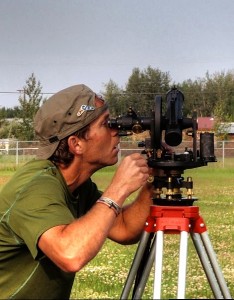
More than a million acres have burned in the 446 wildfires in Alaska this season. That’s an area larger than Rhode Island. Many of these fires are left to burn if they aren’t a danger to people or infrastructure, but the most dangerous of them are battled by hundreds of firefighters and other support personnel. Some fires even warrant their own “incident meteorologist” – or IMET.
Firefighters know weather conditions can change the direction of a fire, putting those attempting to contain it in a potentially deadly position. But specially trained meteorologists, or IMETS, work with fire crews to help better predict the path a fire may take.
There are just 85 certified IMETs nationwide that are prepared to go anywhere in the U.S. on just a few days notice.
Their specialized work helps to keep fire crews and communities safe.
Michael Richmond is an incident meteorologist with the National Weather Service in Anchorage. He has been a part of the IMET crew since 1990 and has been sent to over 25 of these dangerous fires.

up a portable weather stations and monitors the data. Photo courtesy of Michael Richmond.
When he first started, technology limited the effectiveness of the micro-scale forecasts.
“Before the Internet, all we had to use were what were called difex charts,” Richmond said. “We had a little satellite dish that would download these paper charts for all of our radar, satellite pictures and forecast graphics, and they were tiny and they were fuzzy, and that’s all I had to go on.”
But, Richmond says technology has caught up, greatly increasing his effectiveness in the field.
“Now we have real-time data of all sorts: lightning, satellite, radar, everything,” Richmond said. “And it’s a completely different world and I feel so much more confident.”
“So we have almost as good of capability in the field as we do in the office now.”
When an IMET gets deployed, they stay in what’s called the “incident command post,” where the suppression efforts for that specific fire are coordinated. The command posts can sometimes be in very remote areas, which means IMETs need to bring full camping gear.
Despite the remoteness, Richmond says the fire camps certainly aren’t stuck in the stone age.

growing to 554,000 acres by the end of that 2004 summer. Photo by Dave Dallison.
“I’ve seen fire camps develop in 24 hours with full satellite communications, kitchen facilities, laundry facilities, shower facilities,” he said. “It’s really amazing how quickly they can set up a large fire camp with tents, a computer network, electricity, communications, everything.”
Despite high-tech camps and improvements in the technology, Richmond says there are still some limitations.
In 2006, he was at a fire near Stanley, Idaho, in a camp that was situated about 20 miles away from the fire line. The area didn’t have radar coverage, making it impossible for him to provide an accurate forecast.
“Sure enough a small thunderstorm developed and brought winds of 40 to 45 miles an hour; [and] pushed the fire toward the crews,” Richmond said.
They were able to escape but it was more than an hour before the command post knew they were safe.
“So there are realities that we have to deal with in this business, and that’s one of them is that you’re not going to have everything you need and that firefighters have to follow and be able to follow their standard orders and get out of those situations when they occur, because they will occur,” Richmond said.
So far this season, the only place in Alaska an IMET has been dispatched to is the Stuart Creek 2 fire near Fairbanks.
Currently there are 91 active wildfires in the state.
Josh is the Statewide Morning News Reporter/Producer for Alaska Public Media | jedge (at) alaskapublic (dot) org | 907.550.8455 | About Josh




